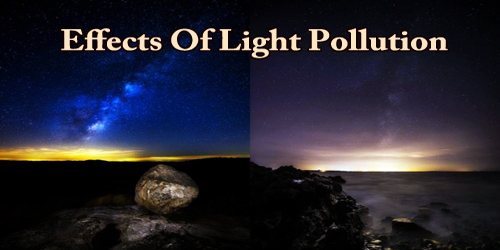Light pollution, unwanted or excessive artificial light. Like noise pollution, a light pollution is a form of waste energy that can cause adverse effects and degrade environmental quality. Moreover, because light (transmitted as electromagnetic waves) is typically generated by electricity, which itself is usually generated by the combustion of fossil fuels, it can be said that there is a connection between light pollution and air pollution (from fossil-fueled power plant emissions). Control of light pollution, therefore, will help to conserve fuel (and money) and reduce air pollution as well as mitigate the more immediate problems caused by excessive light. Although light pollution may not appear to be as harmful to public health and welfare as pollution of water resources or the atmosphere, it is an environmental quality issue of no small significance.
Light pollution is a side-effect of industrial civilization. Its sources include building exterior and interior lighting, advertising, outdoor area lighting (such as car parks), offices, factories, streetlights, and illuminated sporting venues. It is most severe in highly industrialized, densely populated areas of North America, Europe, and Japan and in major cities in the Middle East and North Africa like Tehran and Cairo, but even relatively small amounts of light can be noticed and create problems. Awareness of the deleterious effects of light pollution began early in the 20th century, but efforts to address effects did not begin until the 1950s. In the 1980s a global dark-sky movement emerged with the founding of the International Dark-Sky Association (IDA). There are now such educational and advocacy organizations in many countries worldwide.
Effects of Light Pollution –
Light pollution adversely affects professional and amateur astronomers, as well as casual observers of the night sky, because it severely reduces the visibility of stars and other celestial objects. While many people choose to dismiss light pollution as being the price of modern life, it has serious effects on everything around it.
- People – The wrong kind of light, or too much light has been proven to have an impact on our health and quality of life. Light pollution also increases danger to people as it can interfere with important navigational systems for trains, planes and even automobiles.
- Human health and psychology – Medical research on the effects of excessive light on the human body suggests that a variety of adverse health effects may be caused by light pollution or excessive light exposure, and some lighting design textbooks use human health as an explicit criterion for proper interior lighting. Health effects of over-illumination or improper spectral composition of light may include: increased headache incidence, worker fatigue, medically defined stress, decrease in sexual function, and increase in anxiety. Likewise, animal models have been studied demonstrating unavoidable light to produce adverse effects on mood and anxiety. For those who need to be awake at night, a light at night also has an acute effect on alertness and mood.
- Animals – Lights can attract or repel animals and insects. Most animal life functions on a diurnal or nocturnal system that is thrown out of sync by light pollution. This can place entire species in danger, or attract unwanted species into human areas.
- The Earth – The Earth’s ecosystem is dependent on cycles of natural light. SkyGlow alone can cause a loss in growth protection as the reflected light off the atmosphere will prevent the natural UV rays from reaching the Earth. This disrupts growth and decay cycles that our food, air, and water supply is dependent on.
Inspection of the area surrounding Madrid reveals that the effects of light pollution caused by a single large conglomeration can be felt up to 100 km (62 mi) away from the center. The global effects of light pollution are also made obvious. The entire area consisting of southern England, Netherlands, Belgium, West Germany, and northern France have a sky brightness of at least two to four times normal. The only places in continental Europe where the sky can attain its natural darkness are in northern Scandinavia and in islands far from the continent.
Light pollution affects the visibility of diffuse sky objects like nebulae and galaxies more than stars, due to their low surface brightness. Most such objects are rendered invisible in heavily light-polluted skies above major cities. A simple method for estimating the darkness of a location is to look for the Milky Way, which from truly dark skies appears bright enough to cast a shadow.
Light pollution can be reduced by using well-designed light fixtures with modern optical controls to direct the light downward and also by using the minimum amount of wattage for the area to be illuminated. National and local government agencies can help by passing and enforcing appropriate light-control laws and ordinances.
There are two basic approaches to solving light pollution – planning and education. Planning means more consideration about how areas are zoned and where lights are placed. It also means changing the types of lights used within the home, signs, and streetlamps to more efficient bulbs, and with a light output that is not so disruptive. Education is also key. The more people understand the importance of turning off lights to conserve energy and reduce light pollution the faster change will be seen.
Information Sources:
















